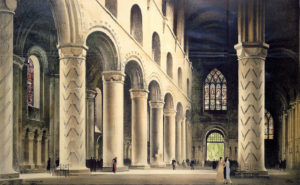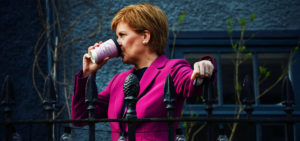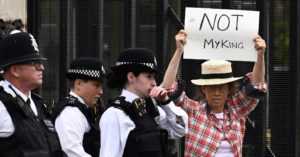When the Queen died at her country estate in Scotland, crowds lined the streets as her hearse crept its way from Balmoral to Edinburgh. There were no indications that her subjects north of the border mourned her any less than those in the south; indeed when Jacki Pickett, an anti-monarchist in the highland village of Muir of Ord posted a video of herself holding a sign reading “Lizard Liz is dead” a mob descended on her fish and chip shop and she had to be rescued by the police.
After years of drifting apart, the United Kingdom suddenly felt united again. It couldn’t last, of course, and it hasn’t: a new UnHerd Britain poll reveals that while 55% of UK citizens agree that it’s a good thing Britain has a monarchy, in Scotland only 45% do.
Yet while the results are unlikely to put a smile on King Charles’s face, they are not, in the end, all that surprising. If anything, they represent a reversion to historic norms, following the fever dream of grief that broke out upon the Queen’s death. Previous surveys on Scottish attitudes to the monarchy have also shown that the Royal Family is not especially popular: shortly before the Platinum Jubilee, for instance, a poll found that fewer than half of Scots supported keeping the monarchy, while the Royals were similarly unloved four years before that. On a visit home last summer, I found that while Tesco had decked out even the frozen meat aisle with “happy and glorious” banners to mark the Queen’s jubilee, it was a lot harder to find signs of celebration in Scottish shops and institutions. The management of the purportedly “Royal” Botanic Garden in Edinburgh had tucked their jubilee sign away in a corner, while at the celebratory garden party in my hometown of Dunfermline, there were no royal souvenirs, not even a mug — although there was a cut out of John Forbes, a long-dead local worthy who founded the city of Pittsburgh.
It may be tempting to connect increasingly negative attitudes to the monarchy with the rise of nationalist sentiment since devolution. Prominent cultural figures, such as the author Alasdair Gray and the SNP politician Margo MacDonald, espoused republicanism. Nicola Sturgeon’s anointed disciple, Humza Yousaf, has vowed not only to break up the UK using “any means necessary”, but also declared on Monday that within five years of independence, he’d expect Scotland to find a new head of state. But republicanism isn’t merely an SNP talking point; Scotland’s bad relationship with monarchy goes back a long way, at least as far back as the Reformation, nearly five centuries ago.
Calvinism, the national philosophy that came to dominate afterwards, is an innately levelling creed, with its cheerful teaching that God has already decided who is saved and who is damned and there is nothing you can do about it. Post-Reformation, the inhabitants of Dunfermline managed to forget where they buried no fewer than seven Scottish kings, including one of the greats, Robert the Bruce, who was only rediscovered by accident in the 19th century. In Scotland, the monarch was not the head of the church; the ministers elected their own leader. John Knox, who spearheaded the Reformation, neither admired nor feared monarchs and reduced Mary Queen of Scots to tears in front of her own court. George Buchanan, the tutor of Mary’s son James, was the author of The Law of Government Among the Scots, wherein he wrote that “the people have the right to confer royal authority upon whomever they wish”, and that they were free to overthrow — and kill — tyrants. Buchanan freely admitted to having “whipped the king’s arse” when the heir to the throne annoyed him.
Chafing against the ideas that his Calvinist tutor had tried to impose upon him, James threw off any restraints on his power as soon as he could, describing monarchy as “the supremest thing on earth” after he became king of England as well as Scotland. His son Charles I attempted to rule in the same way, but when in 1637 he tried to bring the Scottish church to heel by forcing it to accept the Anglican Book of Common Prayer, the people did not meekly comply but rather rose up in anger, resulting in two wars of rebellion. Taking a leaf out of George Buchanan’s book, the Scots did not accept the King’s authority if it conflicted with the will of God (although they later agreed to fight for him when he agreed to support Presbyterianism).
But if the Scots were less than keen on monarchs, then the feeling seems to have been mutual. For a period of almost 200 years, following a brief appearance by Charles II in 1650, no king bothered to make the journey north of the border until George IV (described by Robert Burns as “a witless youth”) toured Scotland in 1822. This trip, in which the portly King appeared in a mini-kilt and pink tights, appears to have presaged a kind of thaw, and inadvertently laid the seeds of today’s heritage industry. Sir Walter Scott, at least, was very excited, and the pageant he organised cobbled together so many Scottish tropes that one resident of Edinburgh complained that he had “ridiculously made us appear to be a nation of Highlanders, and the bagpipe and the tartan are the order of the day”.
However, it was with the ascension of George’s granddaughter, Victoria, to the throne that Scotland really seems to have become integrated into the cult of monarchy. Prince Albert purchased Balmoral for his Queen in 1852 while Glasgow, today the most anti-monarchical place in the UK, was referred to as the Second City of the Empire, a title its inhabitants welcomed with pride. Indeed, the whole city was transformed into a monument to Empress Victoria; a statue of the Queen riding a horse (the first equestrian statue of a woman in the UK) stands close to the City Chambers (which she opened in 1888) to this day. This is easy enough to understand: in those days, Britain was winning at geopolitics, and the Scots wanted to be part of the winners’ club. While nationalists today may sometimes complain that Scotland is England’s last colony, the truth is that the Scots were enthusiastic colonisers themselves, proudly extending and administering the power of the British Empress across the globe.
Yet within a few decades of Victoria’s death, that sense of shared triumphalism vanished. My grandmother grew up in Clydebank in the heyday of the radical Red Clydesiders and remembered red flags flying at rallies in the Twenties and Thirties, while my father recalls attending a birthday party in a “communist chapel” in the early Fifties. He also remembers people booing Churchill when he appeared in cinema newsreels, and yet despite this radicalism, he has no memory of anyone booing the Queen. Indifference rather than hostility was the rule; she seemed “remote”.
Similarly, by the time I was growing up in Fife in the Eighties and Nineties, it was a given that the Royal Family were ludicrously posh and rich and out of touch, but we also accepted that that was kind of the point. Prince Charles may have liked to stride around Lochnagar in a kilt and paint landscapes of the Scottish wilderness, but this did not endear him to the masses; indeed, all that stuff about talking to plants inspired mocking impersonations at my school, and beyond. The Scottish comedian Craig Ferguson took his exceptionally cruel portrayal to the US, where it became a regular feature on his late-night chat show.
For all the talk of the Queen’s love of Scotland, which was emphasised after she died at Balmoral, it does seem that this profound emotional attachment was more than a wee bit correlated with that majestic estate. Although I do not doubt that the Queen was absolutely sincere when she spoke of her “deep and abiding affection for this wonderful country”, I don’t think it’s too much of a stretch to suggest that anybody who spends every summer in a castle surrounded by beautiful forests could reasonably be expected to love it. Indeed, I might never have emigrated to the US if Balmoral were my holiday home. By contrast, the Queen spent much less time at her official residence, the Palace of Holyrood House in Edinburgh.
Yet for all that, I do not recall meeting many vocal republicans until I went to university, and they were all English. The nationalists that I knew in the Nineties — and I knew somebody who ran (unsuccessfully) for the UK parliament — never talked about the Queen or her family. They weren’t fans, of course, but they didn’t care that they weren’t fans: the Royals were simply irrelevant. It is not until 2004 that the republican “Declaration of Calton Hill” — a spirited call for “an independent Scottish Republic built on the principles of liberty, equality, diversity and solidarity” — was issued, to coincide with the Queen’s visit to open the Scottish parliament. It attracted support from significant Scottish cultural figures such as Iain Banks, the poet Edwin Morgan, and Irvine Welsh. But it was organised by the Scottish Socialist Party, which currently has zero seats in the Scottish parliament. Ever since the days of Alex Salmond’s leadership, the official position of the SNP has been to retain the monarchy.
None of this is to say that I don’t think republicanism could become a serious force in Scottish politics. If Scotland were to become independent, then the lowest hanging fruit for nationalists to go after to maintain their sense of existential purpose would be the abolition of the monarchy, as Humza Yousaf’s sudden interest in republicanism makes clear. But until that day comes, the Royal Family simply will continue to be unpopular in Scotland, and poll after poll will reveal that they are unpopular, but it will not matter at all. Always “there” but never actually present, they will drift by on TV screens, occasionally turn up to open a building, and then go away again.
And Scottish apathy might, in the end, be for the better. Because although it is nice to think that we have an inherent aversion to authority, Scots were actually quite respectful towards Calvinist preachers for many centuries, and — as the willing submission to an extended lockdown revealed — the pursRed-lipped, finger-wagging, moralising style of leadership still has quite a constituency in the country. If not King Charles, then who? I’ll take my chances with the Royals, thank you.
Disclaimer
Some of the posts we share are controversial and we do not necessarily agree with them in the whole extend. Sometimes we agree with the content or part of it but we do not agree with the narration or language. Nevertheless we find them somehow interesting, valuable and/or informative or we share them, because we strongly believe in freedom of speech, free press and journalism. We strongly encourage you to have a critical approach to all the content, do your own research and analysis to build your own opinion.
We would be glad to have your feedback.
Source: UnHerd Read the original article here: https://unherd.com/





